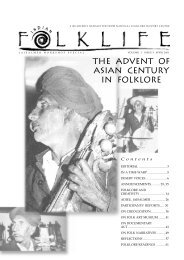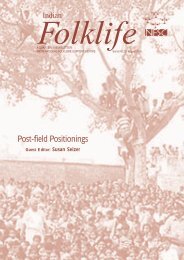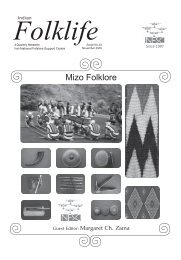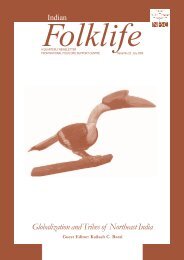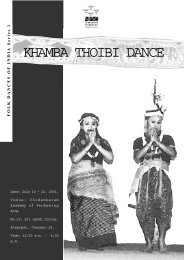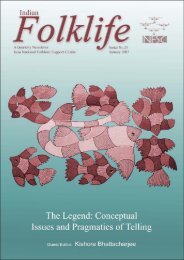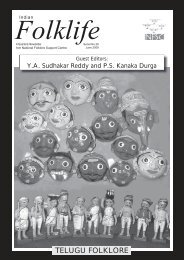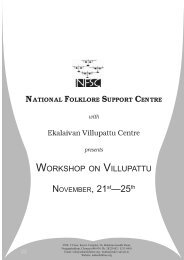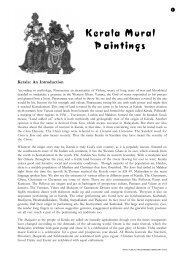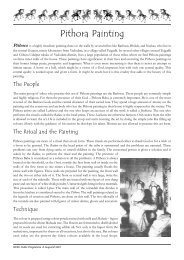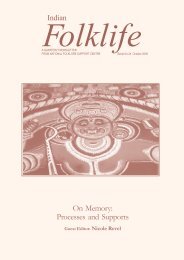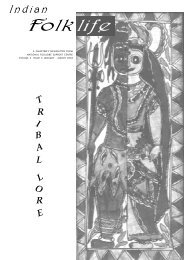Tripura Folklore - Wiki - National Folklore Support Centre
Tripura Folklore - Wiki - National Folklore Support Centre
Tripura Folklore - Wiki - National Folklore Support Centre
Create successful ePaper yourself
Turn your PDF publications into a flip-book with our unique Google optimized e-Paper software.
4<br />
The Land<br />
SAROJ CHAUDHURI<br />
Retired Reader in English,<br />
Department of Higher Education,<br />
Government of <strong>Tripura</strong><br />
A<br />
look at the map of eastern India shows<br />
a strip of Indian territory protruding<br />
into Bangladesh from the southeast<br />
-- that is <strong>Tripura</strong>. Slightly bigger than<br />
Sikkim among the eight north eastern states,<br />
<strong>Tripura</strong> remained lesser known because<br />
of the difficulties in transportation and<br />
communication. The present shape and size of<br />
the state is truncated as a result of the partition<br />
of India. The difficulty of communications is<br />
man-made. Originally, the princely state of<br />
<strong>Tripura</strong>’s boundary extended on all three sides<br />
into the lands of erstwhile East Pakistan. The<br />
state consisted of hilly tracts and plains. Most<br />
of the plains were cut off during partition,<br />
taking away the entire transportation system<br />
with them. The present day state of <strong>Tripura</strong><br />
is the area which was previously known as<br />
‘Hill <strong>Tripura</strong>.’ Now, the state is surrounded<br />
on all sides by foreign territory, except for a<br />
narrow tract of land in the east connecting it<br />
with Assam and Mizoram. The border with<br />
Mizoram is virtually inaccessible, thanks to the<br />
intercepting hill ranges. <strong>Tripura</strong>’s only link<br />
with the rest of the country is through Assam,<br />
and that too through a winding and tortuous<br />
highway. And though the capital of the state is<br />
connected to Kolkata and Guwahati by air;<br />
it is not the usual means of travel for the<br />
common man.<br />
The last ruler of <strong>Tripura</strong> in pre-independence<br />
times, Maharaja Bir Bikram Kishore Manikya<br />
(1923-47) prior to his death (months before<br />
independence) had expressed his intention of<br />
acceding to the Indian Union. Accordingly,<br />
the regent queen signed the instrument of<br />
accession. The administration of the state was<br />
taken over by the Government of India in<br />
October 1949. Through the stages of Part-C<br />
state, and Union Territory, <strong>Tripura</strong> earned the<br />
status of a state in January 1972. In a sense,<br />
<strong>Tripura</strong> is probably<br />
among the worst<br />
affected states due to<br />
partition. It not only<br />
lost its fertile cropgrowing<br />
land and its<br />
system of transport and communication,<br />
but also had to bear the brunt of each exodus<br />
that accompanied the socio-political upheavals<br />
in the adjoining country. The demographic<br />
character of the state is forever changing with<br />
the surge of displaced people from across<br />
the border.<br />
<strong>Tripura</strong> is filled with lush green bamboo and<br />
cane groves, dark primeval forest, transparent<br />
lakes and dancing streamlets. Plains and hills<br />
alternate each other. Seven long hill ranges<br />
run across the land at regular intervals. The<br />
hills are modest, never raising their heads<br />
over a thousand odd metres. The rivers are<br />
neither broad nor deep enough to inspire<br />
awe or allow heavy navigation. They are<br />
stretches of undulated strips between hills.<br />
Our knowledge about the earliest human<br />
settlements in this region is extremely limited.<br />
It is presumed that communities migrated<br />
from North-east, South-east and West. The<br />
earliest settlers are believed to belong to the<br />
same origin as the ‘Kacharis.’ Later, other<br />
ethnic groups also settled here. The Royal<br />
house maintained a close contact with Bengal,<br />
fostering education, trade and commerce; as a<br />
result, a Bengali population also grew. From<br />
the ancient times, the population of <strong>Tripura</strong><br />
shows a chequered pattern of variety. Among<br />
the original inhabitants, there are as many as<br />
nineteen ethnic groups, many having their<br />
own language and cultural tradition. Among<br />
them, the dominant language and tradition is<br />
that of the Tripuris. The language is known<br />
as Kokborok. It belongs to the Bodo branch<br />
of the Tibeto-Burmese family of languages.<br />
Eight communities, out of the nineteen<br />
groups of original inhabitants of <strong>Tripura</strong><br />
speak this language or some variety of it.<br />
Besides, some other indigenous people of the<br />
state and adjacent areas also use Kokborok<br />
as their language for communication. The<br />
other important language in the state is<br />
Bengali. Besides, Manipuri, Chakma and Mog<br />
languages also are used by a considerable<br />
number of people. Kokborok and Bengali are<br />
the two state languages.<br />
INDIAN FOLKLIFE SERIAL NO.35 JANUARY 2010



